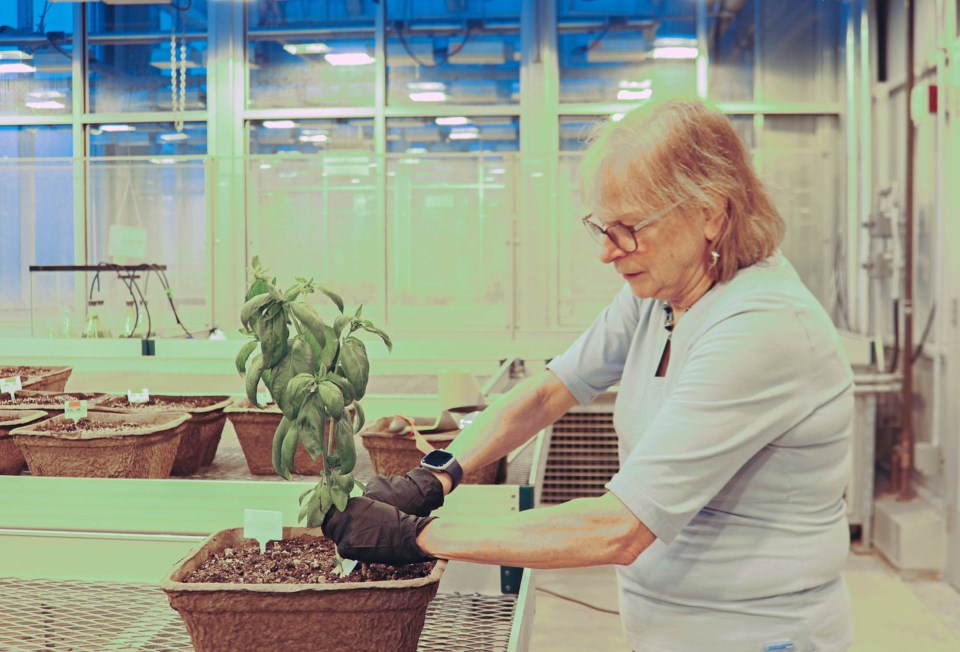NEWS RELEASE
BROCK UNIVERSITY
******************************
When Jennifer Osborn and her partner added two sheep to their farm almost 20 years ago, their aim was to produce wool that could be used to make clothing and other goods.
As their sheep multiplied, so did the wool piling up after each shearing. Osborn searched for buyers but wondered if she needed to find a new market for her product.
Through a partnership with Brock University researchers, she’s now exploring a solution that not only addresses her own dilemma but also offers farmers a sustainable option to support crop growth.
After coming across reports that wool enhances soil, Osborn launched a business, EcoWool Canada, that markets the fibre as a potential natural fertilizer.
“The one thing I'm consistently asked about is the research needed to explain what wool does to the soil,” says Osborn. “I can tell you anything I want, but there needs to be scientific data to show that our wool pellets enrich the soil.”
To get data, Osborn turned to Brock, which is a member of the Ontario-based Greenhouse Technology Network (GTN). The University, through a series of research projects, has been working to enhance the sustainable agriculture sector and is launching a research farm to continue these efforts.
Professor of Biology Liette Vasseur and assistant professor of Chemistry Vaughn Mangal are working with Osbourn to determine the effectiveness of EcoWool’s pellets as a soil amendment to improve soil health, fertility and crop performance.
A soil amendment is any substance — excluding fertilizers, pesticides, agricultural lime and untreated manures — that aims to change chemical or physical characteristics of soil.
Research shows wool contains carbon, hydrogen, nitrogen, oxygen and sulfur, which are among the elements that boost soil quality. Wool provides further benefit by aerating the soil, retaining moisture, improving water infiltration and reducing erosion.
To test EcoWool’s wool pellets, Vasseur and Mangal are growing spinach, sweet peppers, marigolds, basil and yellow beans in pots containing either pellets, conventional fertilizers or nothing added to the soil at all.
Every activity is being recorded during the experiment, such as how much water is added, and plants are monitored and weighed at the end.
After harvesting the crops, the researchers will use sophisticated instruments at the Brock-Niagara Validation, Prototyping and Manufacturing Institute (VPMI) to measure organic carbon and nitrogen quantity and quality of soil and water samples.
“What we’re doing is saturating the soil in the pots so that water comes out of the soil,” says Mangal. “We then collect the leaching water for nutrient and carbon analysis to see how much carbon and nutrients are retained and lost in soils containing the EcoWool pellets.
"This research wouldn't be possible without the cutting-edge analytical equipment at the VPMI,” says Mangal. “Access to this equipment has allowed us to bridge soil chemistry, carbon cycling and plant physiology towards developing more sustainable greenhouse practices.”
Mangal and Vasseur have completed one round of growing and harvesting the plants and will undergo another 55-day experiment of growing, monitoring, harvesting and soil testing before they produce their final report for EcoWool.
In addition to supporting Osborn’s company, Vasseur says the research may encourage the greenhouse industry in Niagara and beyond to use wool pellets as an environmentally sustainable way to boost their crops’ soils.
Vasseur notes that peat moss — harvested from natural peatlands that take thousands of years to regenerate — is currently being used in the industry to increase soil balance.
“If more carbon is stored in the soil, EcoWool pellets may also partially replace peat moss,” she says, adding that peatlands are one of the most important habitats that absorb carbon dioxide and therefore need to be protected to mitigate climate change impacts.
Osborn is also passionate about protecting the environment. It’s “common practice” for sheep farmers to burn their excess wool, she says, noting that wool is 50 per cent biogenic carbon, which is similar to wood.
“Burning the wool alters the path of the carbon, releasing it from the natural cycle and having it contribute to the atmospheric carbon,” she says. “Pelletizing wool keeps that biogenic carbon in the natural system, which is considered carbon neutral.”
The Greenhouse Technology Network (GTN) is a consortium of research-focused centres that increases innovation capacity to grow the Ontario greenhouse industry. Members collaborate with greenhouse and related technology businesses in southern Ontario and solve challenges through applied research projects.
GTN is supported by a $5-million Government of Canada investment through the Federal Economic Development Agency for Southern Ontario.
******************************
